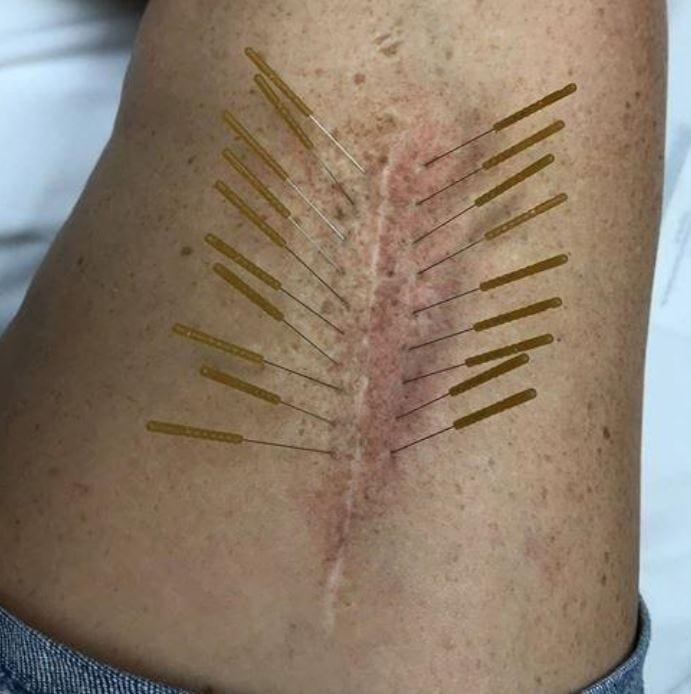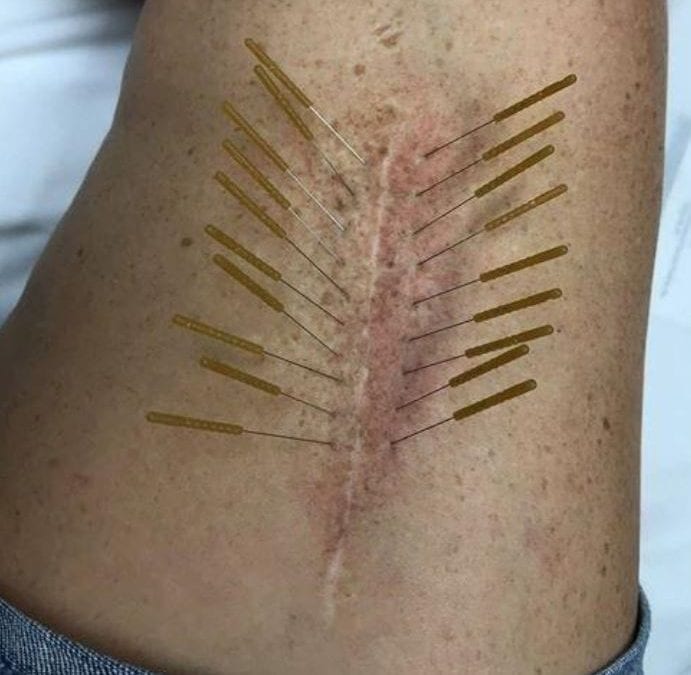Griswold D, Wilhelm M, Donaldson M, Learman K, Cleland J. The effectiveness of superficial versus deep dry needling or acupuncture for reducing pain and disability in individuals with spine-related painful conditions: a systematic review with meta-analysis. Journal of Manual & Manipulative Therapy. 2019:27(3) (128-140).
Abstracted by Kimberly Ennis PT, DPT, ScD, OCS, COMT Bentonville, AR – Fellowship Candidate, IAOM-US Fellowship Program & Jean-Michel Brismée, PT, ScD, Fellowship Director, IAOM – US Fellowship program
Research: To review current literature comparing the efficacy of superficial versus deep dry needling for individuals with spinal pain.
Methods: An electronic database search was completed using PubMed, CINAHL, Scopus, and Cochrane Central. Results were filtered to include randomized controlled trials or clinical trials comparing deep to superficial dry needling or acupuncture for the treatment of spine-related painful conditions. Superficial needling was defined as insertion depths <10mm, while deep needling included depths >10mm. Two authors screened titles for inclusion. Twelve manuscripts were included in the systematic review and ten in the meta-analysis. Standardized mean differences (SMD) with 95% confidence intervals were calculated for pain and disability.
Results: Ten of the studies in the meta-analysis suggested a statistically significant effect of needling depth on pain reduction at all time intervals including immediate effects, short term (1-11weeks), and >12weeks. A greater effect was also shown with local needling versus remote needling to the region of pain. The risk of bias was unclear, meaning results should be interpreted cautiously.
Conclusions: The results of this meta-analysis suggest that deep dry needling may be more effective in treating spine-related pain than superficial dry needling. No significant difference existed between superficial and deep dry needling for disability measures.
IAOM-US comments: Dry needling is an intervention using a filiform needle to penetrate the skin and stimulate underlying myofascial trigger points and connective tissues for the management of neuromusculoskeletal pain and movement impairments. Dry needling can be subdivided into deep and superficial; selection of dry needling depth is based on the intent of the practitioner. The primary differences between deep and superficial dry needling is 1) the depth of penetration and 2) whether or not a local twitch response is desired1. A local twitch response (LTR) is a spinal cord reflex that is characterized by an involuntary contraction of the contractured taut band, which can be elicited by penetration with a needle 2,3. Deep dry needling typically includes needles greater than 10 mm in length and has been shown to deactivate trigger points by eliciting LTRs. The LTR response has been associated with mitigation of spontaneous electrical activity at the motor endplate, a reduction in nociceptive and inflammatory chemicals, and relaxation of the taut band2,3. It normalizes the pH and chemical milieu of skeletal muscle and restores local circulation4,5,6. Deep dry needling has been associated with improved range of motion and reduced local irritation of the TrP as well as in its referral pattern. Superficial dry needling is believed to stimulate mechanoreceptors coupled with unmyelinated C fiber afferents resulting in indirect stimulation of the anterior cingular cortex7. Superficial dry needling may also be mediated through stretching of fibroblasts or stimulation of the A-delta-fibers8. Superficial dry needling has been associated with improvements in range of motion as well as local and referred pain, although it is unknown whether it has similar effects in normalizing the chemical environment and diminishing the motor endplate noise of the myofascial trigger point. Superficial dry needling is not associated with eliciting an LTR. Superficial dry needling can be used when analgesics are either unavailable or undesirable, addressing scar tissue, where anatomy demands it, such as with the scaleni management, or for periosteal pecking for conditions such as Tietze’s syndrome or lateral epicondylagia1. It is the recommendation of the IAOM that superficial dry needling be used to assess patient’s response to dry needling and to address pain modulation, whereas deep dry needling should be used when a trigger point is identified, and relaxation of the taut band and mitigating the trigger points pain referral pattern is desired.

Figure 1: Deep dry needling of the infraspinatus muscle using needles longer than 10mm.

Figure 2: Superficial dry needling used to address adhered scar tissue. Needle depths <10mm.
References:
- American Physical Therapy Association (APTA). Description of dry needling in physical therapy practice: an educational resource paper. 2013(1-7).
- Hong CZ. Lidocaine injection versus dry needling to myofascial trigger point. The importance of the local twitch response. Am J Phys Med Rehabil. 1994;73(4):256-263.
- Tekin L, Akarsu S, Durmus O, Cakar E, Dincer U, Kiralp MZ. The effect of dry needling in the treatment of myofascial pain syndrome: a randomized double-blinded placebo-controlled trial. Clin Rheumatol. 2013 Mar;32(3):309-15.
- Shah JP, Gilliams EA. Uncovering the biochemical milieu of myofascial trigger points using in vivo microdialysis: an application of muscle pain concepts to myofascial pain syndrome. J Bodyw Mov Ther. 2008;12(4):371-384.
- Shah J, Phillips T, Danoff JV, Gerber LH. A novel microanalytical technique for assaying soft tissue demonstrates significant quantitative biomechanical differences in 3 clinically distinct groups: normal, latent and active. Arch Phys Med Rehabil. 2003;84:A4.
- Shah JP, Danoff JV, Desai MJ, et al. Biochemicals associated with pain and inflammation are elevated in sites near to and remote from active myofascial trigger points. Arch Phys Med Rehabil. 2008;89(1):16-23.
- Olausson H, Lamarre Y, Backlund H, et al. Unmyelinated tactile afferents signal touch and project to insular cortex. Nat Neurosci. 2002;5(9):900-904.
- Baldry PE. Acupuncture, Trigger Points and Musculoskeletal Pain. Edinburgh: Churchill Livingstone; 2005.

